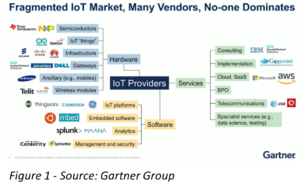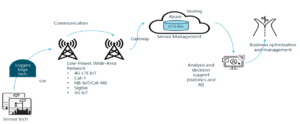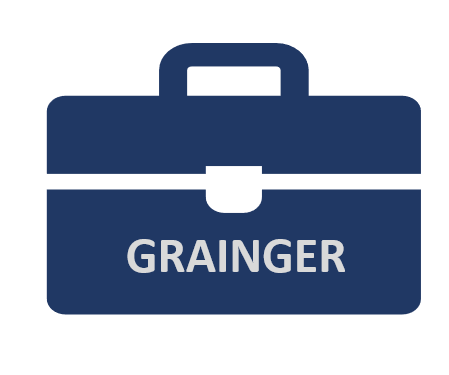For almost a year now, I have worked with the implementation of an IoT platform, which is going to help The Danish Environmental Protection Agency with collecting information about the climate.
The climate is changing and to follow the development, it is necessary to measure the changes and the causes to build models, which can show how to counter the changes or ensure that we can live with them.
This work requires data – a lot of data that is most easily retrieved through sensors, which can intercept the necessary information about wind, water, etc. In other words, climate adaptation requires at least one or more solutions that can monitor the climate and provide the necessary data that climate adaptation requires. Because without data, we might as well give up the fight.
Maturity leaves much to be a desire
IoT has been a buzzword since the end of the last millennium but technology has not taken the big leap forward, so we today can call it a mature technology.

Figure 1 is fragmented and shows that in principle it is only large industrial companies that are successful with IoT. It shows that there are many players with different backgrounds and capabilities on the field at the same time, which makes it difficult to put together a general and standardized end-to-end solution.
However, this is not the primary reason behind Denmark’s Environmental Portal’s choice to make IoT services available. The real reason is that the portal is nowadays being disrupted by various proprietary IoT solutions, which will, in the future, make it difficult to collect, store and distribute new environmental data.
Concerning the choice of the platform, Denmark’s Environmental Portal has chosen a SaaS that fits with the MS Azure Cloud solution, which all other solutions are built on in the Environmental Portal. Thus, the integration becomes easier, and the solution is based on a few known tools and standards. Unfortunately, the solution is only one piece in the overall IoT picture of how to move data from individual sensors to value-creating systems. When talking about IoT, it is necessary to look at the whole value chain. It contains many elements that must be tied together before you gather the data, analyze it and conclude on it. In other words, there is a journey from waking up in the morning, feeling ill, taking your temperature, and finding out that it is 39.2 until you are diagnosed. In most cases, it requires a call to the doctor, perhaps a visit, an inoculation, and a few blood tests before the doctor can determine what is wrong.
Historically, IoT originates from sensor technology, much of which was developed decades ago. Just think of all the sensors that were built into NASA’s spaceships back in the days and the many engineers who were present in the Kennedy Space Center and monitored the individual sensors.
Because of the Internet, it became possible to connect sensors to the Internet – if you were able to develop a sensor that could communicate through the Internet, had a battery or power supply that ensured a stable flow of data to the user or system that should use it.

The first Coca-Cola vending machine was connected to the Internet in 1982. This created delivery security for cold Cokes. Since then, Coca-Cola has followed up on the success and today they can spot when the machines need to be repaired before they break down, which ones are most used, and make credit card payments, etc. But why has Coca-Cola been successful when other successes have had to wait?
The reason could be that Coca-Cola has had end-to-end control over their IoT solutions and their vending machines have been set up in places where it has been easy to find locations, where there was direct access to electricity and the Internet, and at the same time, Coca-Cola has been able to develop its own solutions within IoT.
It is of course easy when it comes to a vending machine with a stable power supply and located close to a network socket. It becomes more complicated when the sensors have to be placed in the city and even worse when they have to be placed in nature e.g. in streams where battery life and network coverage suddenly become important elements to consider. If we could just use the mobile network from our phones, it would be easier. But often, we lack coverage or G4 is too expensive. Therefore, several LoW Power, Wide-Area Network, have been developed, not all of which are equally good in all situations.
IoT is not out of the box
As it turns out, IoT is not a walk in the park. Establishing a comprehensible IoT solution requires insight into the construction of sensors as well as knowledge of how to make optimal use of several different network technologies. Once the sensor is set up and data flows through a selected network solution, then the next hurdle comes; to analyze and store the data and to ensure that data flow as expected. And this is where Denmark’s Environmental Portal comes into the picture, as we are already experts in gathering, storing, and displaying data. We have built a system that can handle the security around access to data. This expertise has further been developed, so we now also can handle data directly from sensors. The solution allows you to manage the sensors including adding, editing, and deleting the sensors.
In addition to managing the sensors, the solution we have established can also handle user access and control:
- User administration with login and passwords is done through a simple screen. If the user forgets his/her password, he/she can get a new password.
- Role-based access control. An administrator can assign different roles to different users by using an administrator module.
- Hierarchical structure.
- A dashboard that can provide information about associated sensors and users’ use of the system, etc.
The solution allows you to manage firmware and production trials. The solution also contains several open APIs, so information can be retrieved to and from the system. The Environmental Portal’s IoT solution contains all the functions needed to run a modern IoT farm. But gathering and storing data does not do it alone – it is only until you have harvested, and the barn is full.
For data to provide value, it must be analyzed and/or used administratively. Denmark’s Environmental Portal applies Power BI, which holds several user-friendly tools for analyzing data and sharing insights. With the IoT solution, you can monitor your sensors, and with Power BI you can combine sensor data with other business data, build dashboards and get an overview of business-critical parameters.
In fact, there is no limit when data is within the house. You can build automatic decision support systems and models based on machine learning and artificial intelligence that more or less automatically perform a series of actions.
But as mentioned above there is a long road from data is harvested until they can be used. However, we hope that this road has become a little shorter for the users of our solution. We are looking very much forward to working with both private companies and public institutions, and together exploit the potential of gathering data and applying it proactively to secure nature and the environment.
By Rebecca and Claus Grainger
